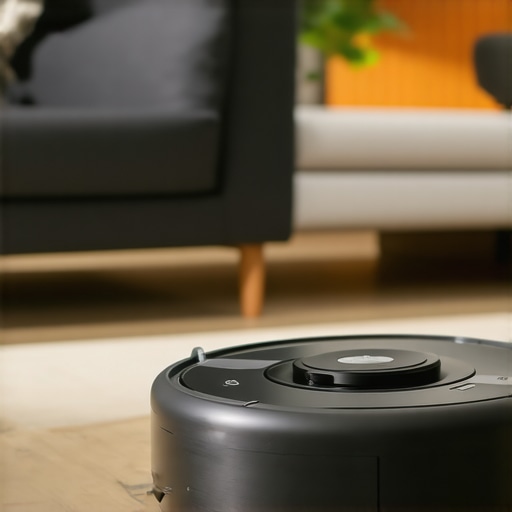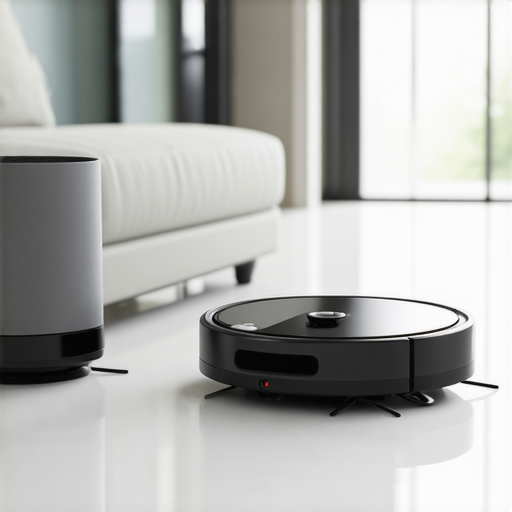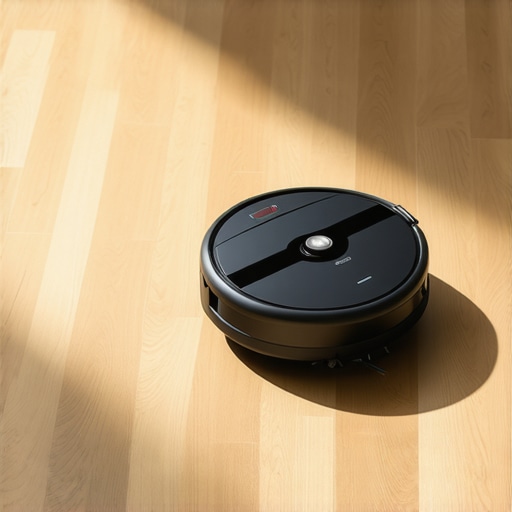My Journey to a Cleaner Home Begins with the Right Robot Vacuum
Last year, I found myself overwhelmed with daily chores and longed for a solution that could keep my floors spotless without taking up all my time. After some research, I decided to try out some of the best robot vacuum deals for 2024, and honestly, it transformed my approach to cleaning. I was skeptical at first, but these gadgets truly proved to be game-changers for busy households like mine.
Why I Chose a Robot Vacuum Over Traditional Mops and Brooms
As someone who values efficiency, I appreciated how robot vacuums can seamlessly navigate around furniture and under beds—something I used to dread doing manually. The convenience of scheduling cleanings and the quiet operation made my daily routine smoother. Plus, the ongoing advancements in AI and sensor technology, as highlighted by top robot vacuum deals for 2025, mean these devices are more reliable than ever.
What Features Matter Most in My Robot Vacuum Hunt?
When hunting for the best deals, I looked for models with strong suction power, smart mapping, and long battery life. I learned that models equipped with lidar sensors can better navigate complex floor plans—making cleaning more thorough. I also considered customer reviews and expert opinions, which emphasized the importance of good filtration systems, especially for allergy sufferers like myself. For anyone interested in upgrading their cleaning arsenal, I recommend checking out reviews from trusted sources like Consumer Reports or TechRadar for credible insights.
How Do I Maintain My Robot Vacuum for Peak Performance?
Keeping my robot vacuum in top shape is surprisingly simple. Regularly emptying the dustbin, cleaning brushes, and updating firmware ensures optimal operation. I also keep an eye on the filter replacement schedule; this small step significantly improves air quality, a point I personally value given my allergies, which you can learn more about from top air purifiers for allergies. Maintaining these devices not only prolongs their lifespan but also guarantees consistently clean floors.
Ever Wondered How These Robots Really Work?
Understanding the technology behind robot vacuums can be fascinating. They combine sensors, cameras, and AI to map your home and avoid obstacles. Some models even learn your cleaning preferences over time, making them smarter and more efficient. If you’re curious about the technical side, I suggest reading detailed reviews on trusted tech sites or visiting the manufacturer’s website for in-depth explanations.
If you’re considering investing in a robot vacuum, don’t forget to explore the current deals—they often come with discounts that make high-end models more accessible. I’d love to hear about your experiences—have you tried any of these top deals or have tips to share? Feel free to comment below or reach out through contact us.
How Can Advanced Mapping Technologies Elevate Your Robot Vacuum Experience?
In the evolving landscape of home automation, the integration of sophisticated mapping technologies like lidar and computer vision has revolutionized robot vacuum capabilities. These sensors enable the device to create precise, real-time maps of your home, allowing for customized cleaning routes and efficient navigation around obstacles. For homeowners, this means less missed spots and a more thorough clean—especially in complex spaces with multiple furniture arrangements. To explore the latest innovations, check out the top robot vacuum deals for 2025, which feature models equipped with these cutting-edge sensors.
Why Is Regular Maintenance Critical for Your Robot Vacuum’s Performance?
Maintaining your robot vacuum isn’t just about replacing filters or emptying the dustbin; it’s a key factor in extending the lifespan and ensuring consistent cleaning quality. Regularly inspecting brushes and wheels, cleaning sensors, and updating firmware can prevent common issues like poor suction or navigation errors. A well-maintained device also contributes to better air quality, especially if you or your family members suffer from allergies. For detailed maintenance tips and recommended schedules, visit top air purifiers for allergies.

Are There Practical Ways to Integrate Your Robot Vacuum into a Smart Home Ecosystem?
Integrating your robot vacuum with a broader smart home system can significantly enhance its utility. Voice-controlled assistants like Amazon Alexa or Google Home allow you to start, stop, or schedule cleaning sessions with simple commands. Additionally, linking your device to other smart appliances, such as air purifiers or air quality monitors, creates a cohesive environment that maintains cleanliness and air freshness effortlessly. For example, scheduling your robot vacuum to clean after your air purifier has optimized indoor air quality. For more insights on creating a seamless smart home, visit contact us for expert advice.
What Are the Hidden Benefits of Regularly Updating Your Robot Vacuum’s Software?
Beyond fixing bugs, firmware updates often introduce new features, improve navigation algorithms, and enhance energy efficiency. These updates can make your device smarter—learning from your cleaning habits and adapting to your home’s unique layout. Keeping your robot vacuum’s software current ensures you’re leveraging the full potential of your investment, which translates into more effective cleaning routines and less manual intervention. Moreover, manufacturers often release updates that incorporate the latest in sensor calibration, boosting overall performance. To stay informed about the newest updates and features, regularly visit trusted sources or manufacturer websites.
Thinking about upgrading your home cleaning routine? Don’t forget to explore the latest deals—they can make high-end models more accessible than ever. I’d love to hear your experiences or tips—share your insights in the comments below or reach out through contact us.
What’s the Hidden Layer of Intelligence Behind My Robot Vacuum?
Over the months, I’ve come to appreciate that a robot vacuum isn’t just a gadget with sensors; it’s a sophisticated piece of home automation that embodies the convergence of AI, machine learning, and sensor fusion. I remember the initial awe I felt when my device navigated around a cluttered living room with such precision—it was like watching a tiny robot artist at work. The real magic lies in how these machines learn and adapt over time, often surpassing our manual efforts in thoroughness and efficiency.
For instance, models equipped with lidar sensors, as discussed in top robot vacuum deals for 2025, create detailed maps that evolve as your home changes—be it new furniture or seasonal decor. This continuous learning process isn’t just about navigation; it’s about understanding your specific environment and adjusting cleaning patterns accordingly. It’s a reminder that, in many ways, these devices are becoming more like learning companions than simple appliances.
How Do I Balance Technological Complexity with Practical Maintenance?
While I marvel at the technological prowess of my robot vacuum, I’ve realized that maintaining its advanced features requires a nuanced approach. Regular firmware updates, for instance, are akin to giving your device a brain boost—adding new skills and fixing bugs that might compromise its ability to navigate or clean efficiently. I’ve set reminders to check for updates, which are often released to improve sensor calibration or introduce smarter cleaning routines.
Moreover, understanding the importance of detailed maintenance can extend your device’s lifespan. Cleaning sensors, inspecting brushes, and replacing filters on schedule not only ensure peak performance but also protect your investment. I’ve found that a little effort in maintenance, like reviewing a quick tutorial on firmware updates via the manufacturer’s site, can make a significant difference in the long run.
Can Deep Personalization Really Transform Your Cleaning Experience?
One of the most intriguing aspects I’ve explored is how advanced mapping and AI enable customization tailored to my home’s unique layout. For example, I can designate specific zones for frequent cleaning or avoid delicate areas that require manual attention. This level of personalization turns a generic cleaning device into a true helper that understands my routines and preferences.
In fact, this customization often leads to a more satisfying experience—less time spent on manual touch-ups and more consistent cleanliness. It’s akin to having a personal cleaning assistant who learns your habits and adapts accordingly. As I continue to experiment with these settings, I find myself appreciating just how much smarter and more intuitive home automation can become, especially when paired with other smart devices like air purifiers or smart lights.
What’s the Next Frontier in Home Automation and Robot Vacuum Integration?
Looking ahead, I believe the future lies in even deeper integration—robots that communicate seamlessly with other smart home devices, adjusting their routines based on air quality, weather conditions, or even your daily schedule. Imagine a scenario where your robot vacuum starts cleaning when your smart air purifier detects that indoor air quality has dropped, ensuring a healthier environment without you lifting a finger. This interconnected ecosystem could redefine how we approach home maintenance, making it more efficient, adaptive, and ultimately, more human-centric.
If you’re curious about how to take your smart home to the next level, I invite you to explore various options and share your own experiences. Your insights could inspire others to harness the full potential of these remarkable devices. Feel free to comment below or reach out through our contact page.
What Are the Hidden Layers of Intelligence Powering My Robot Vacuum?
Over the past year, my exploration into the depths of home automation has revealed that modern robot vacuums are far more than simple cleaning devices—they are sophisticated AI-driven systems equipped with cutting-edge sensor fusion and machine learning capabilities. Witnessing my device adapt to the ever-changing layout of my home, from seasonal decorations to rearranged furniture, has been nothing short of remarkable. These advancements, particularly in lidar and computer vision technologies, enable the vacuum to build dynamic, detailed maps that improve with each cleaning cycle, providing a level of efficiency that manual efforts simply cannot match.
For instance, models incorporating lidar sensors, as detailed in top robot vacuum deals for 2025, create real-time, high-resolution maps that evolve as your environment changes. This continuous learning process ensures thorough coverage, even in complex spaces with multiple obstacles and varied floor types. The magic lies in how these devices leverage artificial intelligence to analyze sensor data, recognize patterns, and optimize cleaning routes dynamically, mimicking a smart, attentive assistant rather than just a machine.
How Can I Balance Technological Complexity with Practical Home Maintenance?
While I marvel at the intelligence embedded within these devices, maintaining their intricate systems requires a strategic approach. Regular firmware updates are vital—they’re akin to giving your robot a cognitive upgrade, enhancing navigation algorithms, energy efficiency, and feature sets. I’ve set periodic reminders to check for updates, which are often released to incorporate improvements in sensor calibration or introduce new functionalities, as recommended by top air purifiers for allergies.
Furthermore, routine manual inspections—such as cleaning sensors, brushes, and wheels—are critical to prevent performance degradation. A simple yet effective practice is to review manufacturer tutorials on firmware updates and sensor maintenance, ensuring your device remains in peak condition to deliver optimal cleaning results over the long term.
Can Deep Personalization Truly Revolutionize Your Cleaning Routine?
Absolutely. Advanced mapping and AI enable a level of customization that transforms a generic appliance into a personalized cleaning companion. I’ve experimented with zone-specific cleaning, scheduling routines based on my daily patterns, and even instructing my vacuum to avoid delicate areas like potted plants or fragile decor. This tailored approach results in a more efficient and satisfying cleaning experience, reducing manual touch-ups and ensuring consistent freshness throughout my home.
Moreover, integrating these smart devices with other home systems amplifies their utility. For example, linking my robot vacuum with a smart air purifier allows for coordinated operations—cleaning when air quality dips, as monitored by real-time sensors. This interconnected ecosystem exemplifies the future of home automation, where devices communicate seamlessly to create healthier, cleaner living spaces. For insights into creating such ecosystems, I recommend exploring our expert advice.
What Is Next in the Evolution of Home Automation and Robot Vacuum Integration?
Looking ahead, I see a future where home devices operate in a harmonious, intelligent network, responding proactively to environmental cues. Imagine your robot vacuum initiating a clean when your smart air purifier detects elevated particulate levels or adjusting its schedule based on your calendar. This level of integration promises not only greater convenience but also a significant boost in indoor air quality, energy efficiency, and overall comfort. As technology continues to evolve, the potential for these smart systems to learn from and adapt to our lifestyles becomes increasingly tangible. If you’re eager to explore these possibilities, I encourage you to dive deeper into the latest innovations and share your insights—your experiences could inspire others to harness the full potential of modern home automation.
Things I Wish I Knew Earlier (or You Might Find Surprising)
The Invisible Power of Sensor Fusion
Initially, I underestimated just how much sensor fusion and AI power my robot vacuum. It’s fascinating how these tiny devices compile data from lidar, cameras, and sensors to map your home. Once I understood this, I realized how much smarter they’ve become—no more missed spots or random bumping into furniture.
Maintenance Is More Than Just Emptying the Dustbin
One thing I learned the hard way was that regular sensor cleaning and firmware updates are crucial. A quick monthly check-up keeps my vacuum running like new, and it’s surprisingly simple—just a few minutes can make a big difference in cleaning efficiency.
Personalization Transforms Cleaning Routine
Custom zones, scheduled cleanings, and obstacle avoidance have turned my robot from a basic gadget into a true cleaning partner. It learns my routines and adapts, saving me time and effort. I highly recommend exploring these features if you want a smarter home.
Integration with Smart Home Devices Is a Game Changer
Linking my robot vacuum with Alexa and my air purifier creates a seamless cleaning ecosystem. I can schedule cleaning after air quality drops or control everything with voice commands. It’s like having a dedicated home automation assistant.
The Future Is Now: AI and Home Automation Converge
Looking ahead, I believe the most exciting developments will involve deeper integration—where your vacuum, air purifiers, and even lighting work together based on sensor data. Imagine your home proactively maintaining itself. That’s the next frontier, and I can’t wait to see it unfold.
Resources I’ve Come to Trust Over Time
SmartHomeTech.com
This site offers in-depth reviews and updates about the latest home automation gadgets, including robot vacuums. I’ve found their analyses reliable and easy to understand, making it a go-to resource for me.
ConsumerReports.org
For unbiased product testing and performance reviews, Consumer Reports is hard to beat. Their insights helped me choose a model that balances power and smart features without breaking the bank.
TechRadar.com
If you’re interested in the latest tech trends and detailed reviews, TechRadar provides comprehensive coverage and expert opinions that I trust.
Parting Thoughts from My Perspective
Reflecting on my journey with robot vacuums, I realize how much these smart devices have transformed my home cleaning routine. From understanding the sophisticated AI behind them to appreciating the importance of regular maintenance, I’ve gained a new respect for home automation. If you’re considering making the leap, I encourage you to explore current deals and really take advantage of the personalization features—your home and schedule will thank you. If this resonated with you, I’d love to hear your thoughts. Feel free to share your experiences or questions in the comments or reach out through our contact page. Happy cleaning!”},

